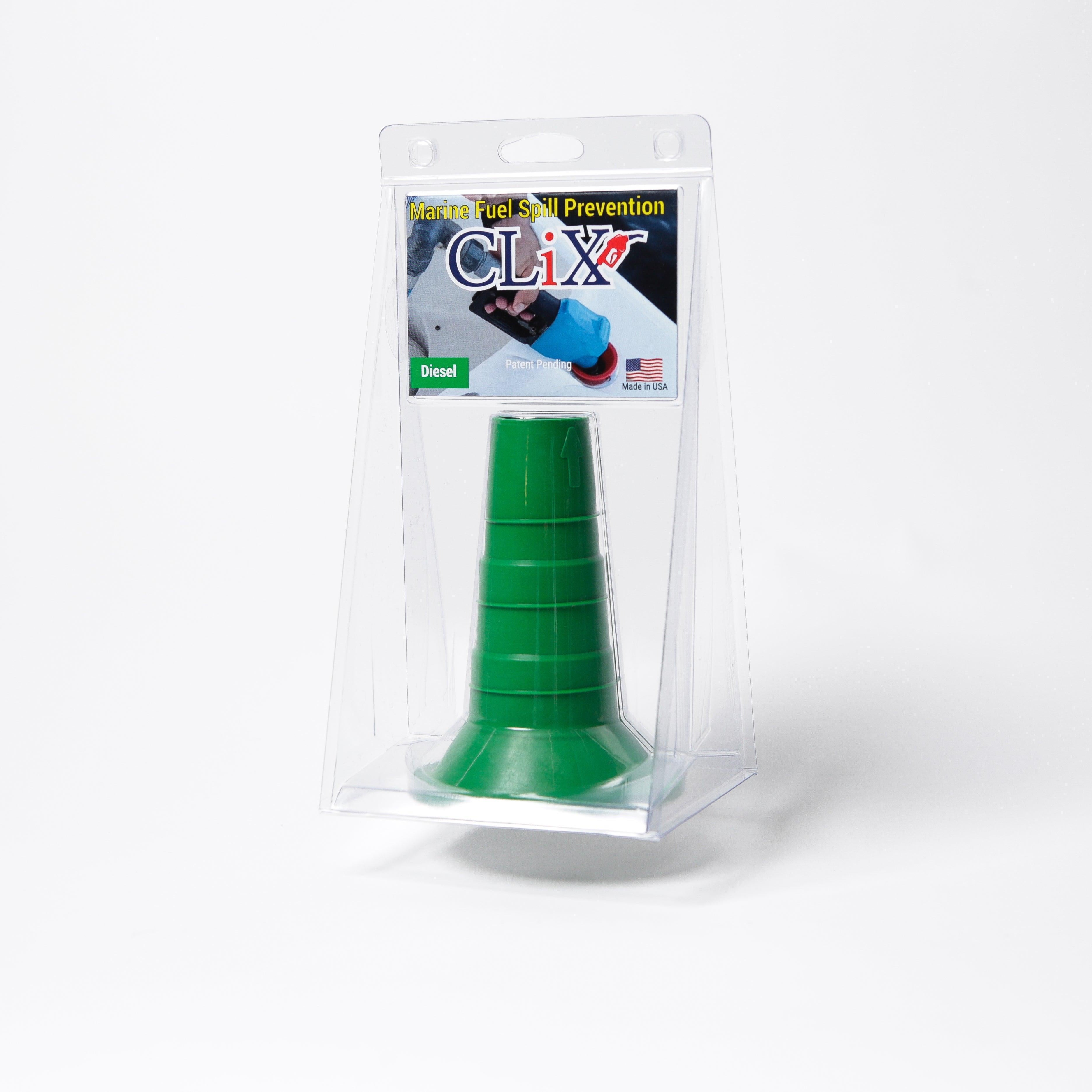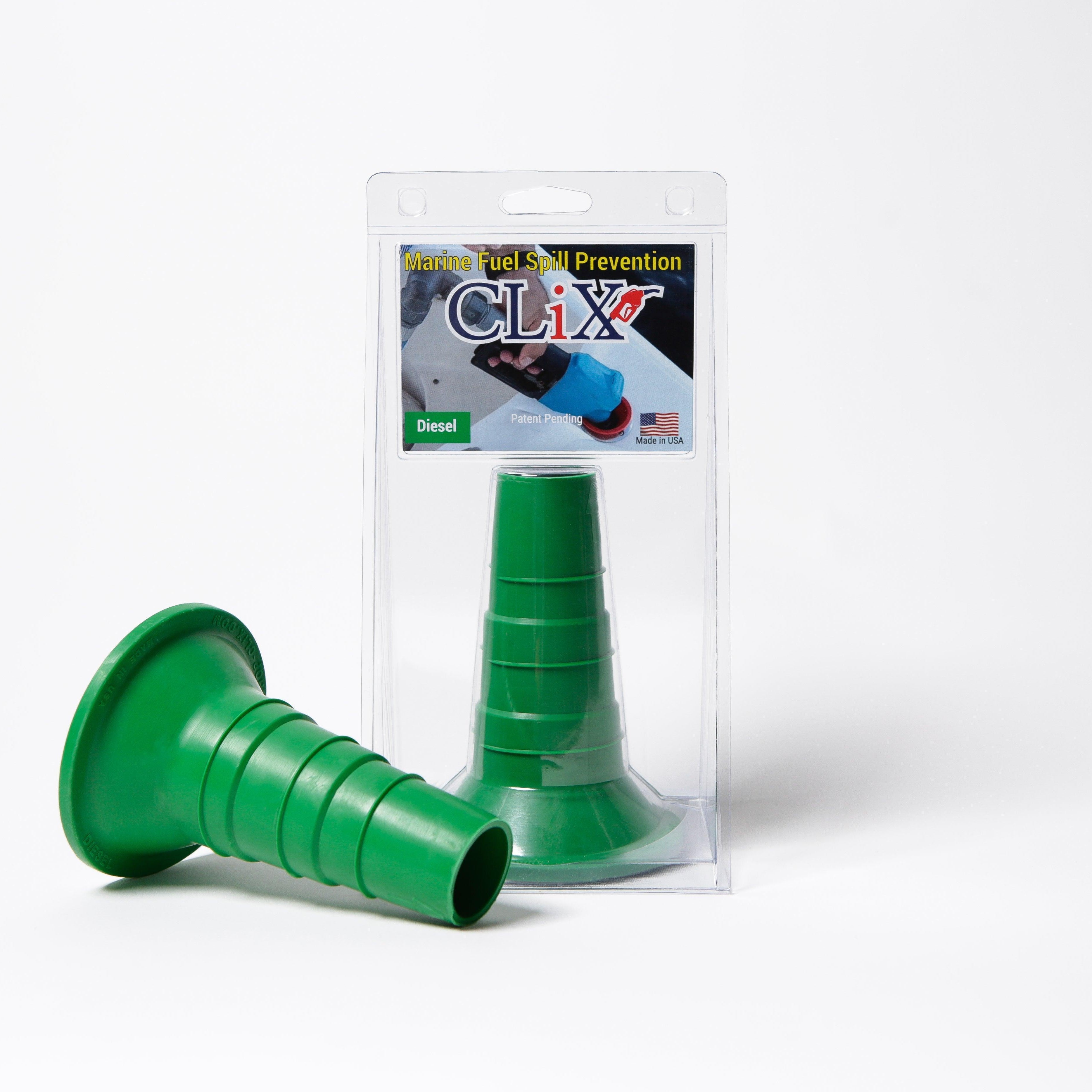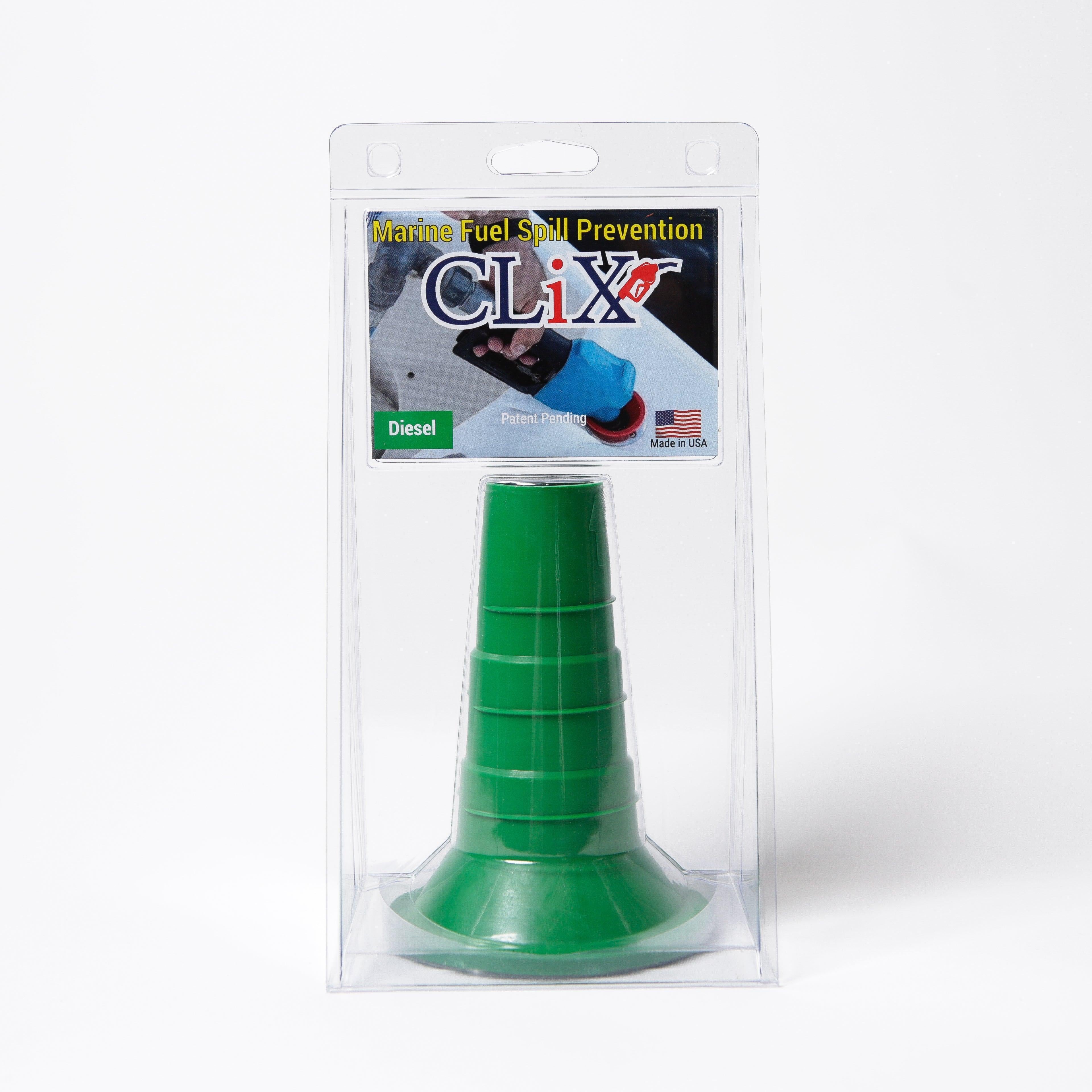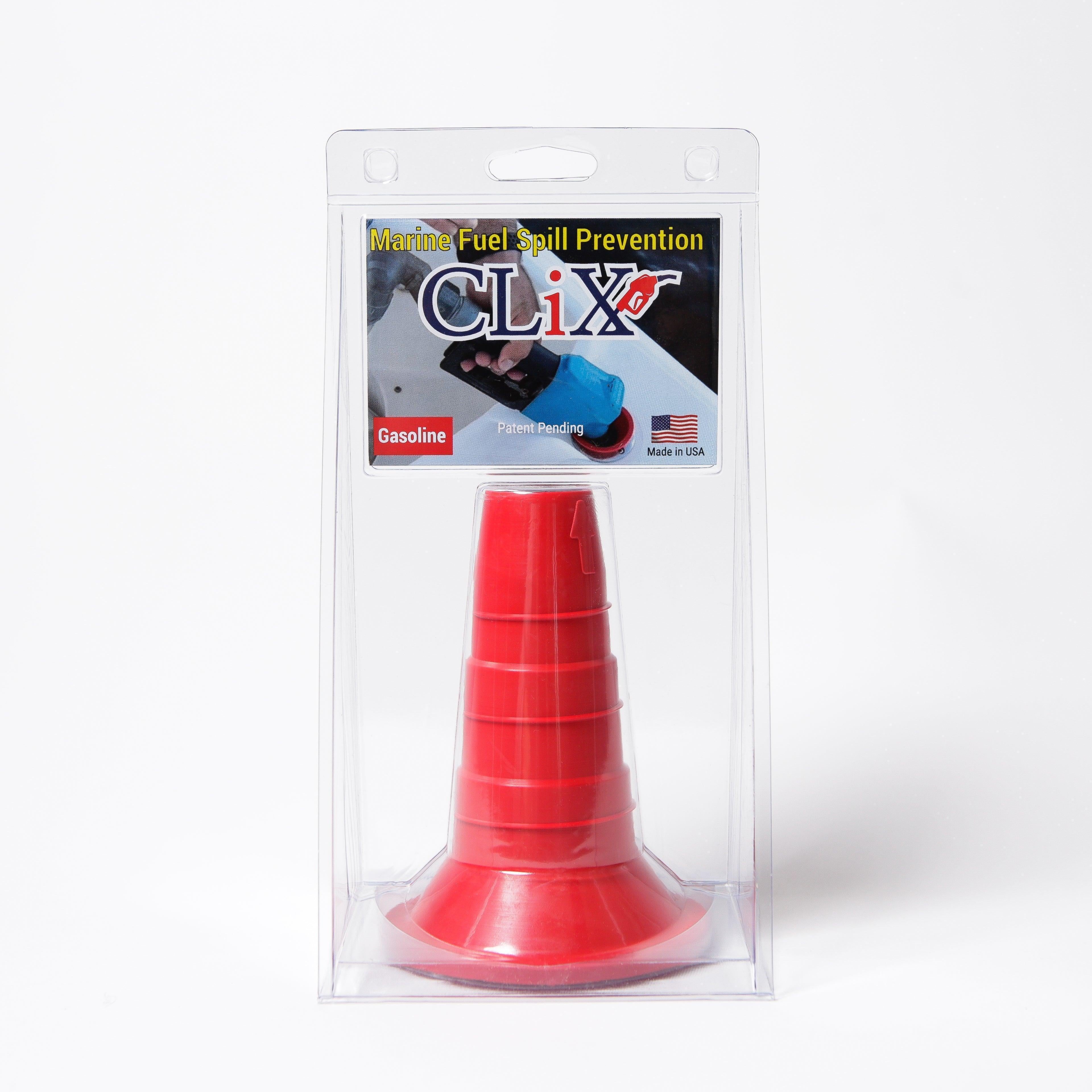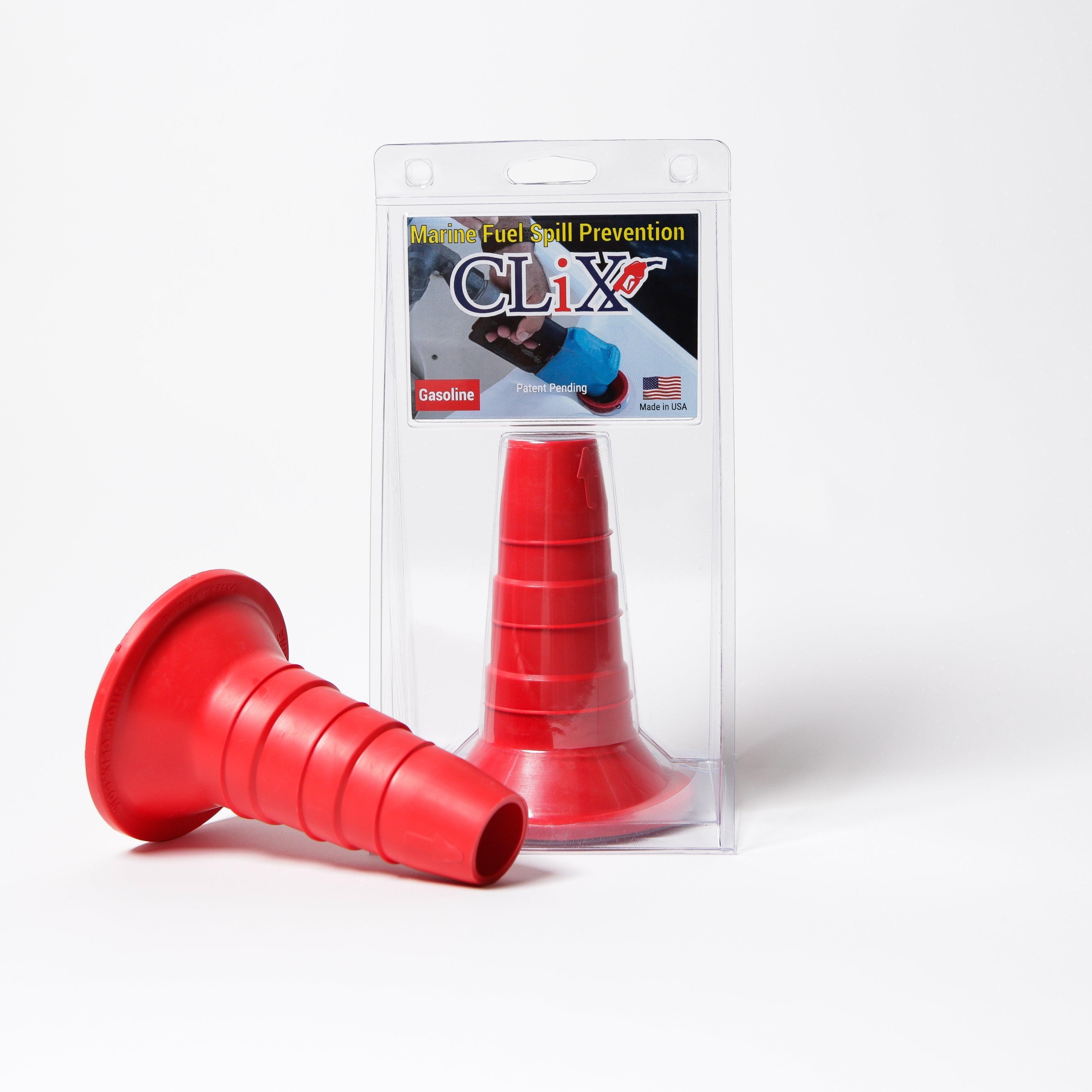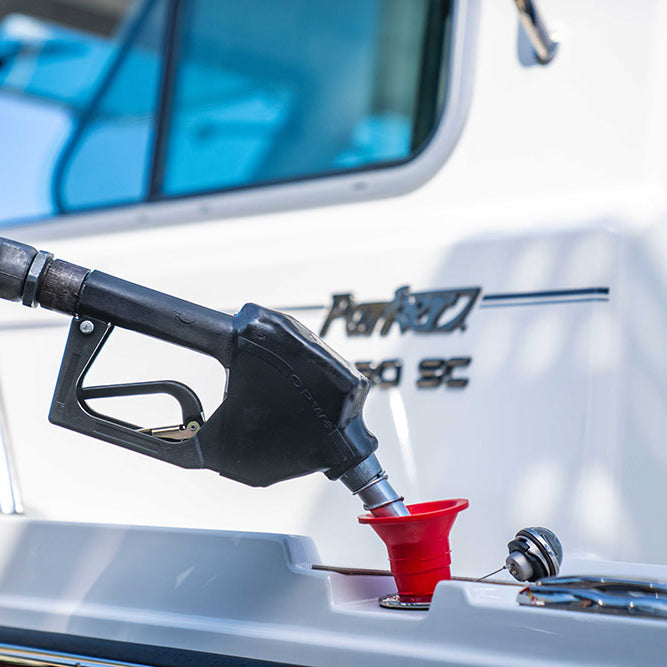When you're out on the water, a portable fuel can is a whole lot more than just a plastic jug. Think of it as your get-out-of-jail-free card, a simple tool that can get you back to the marina when you’ve pushed your luck just a little too far. It's what turns a potential crisis into a minor inconvenience.
Your Fuel Can: A Boater's Most Overlooked Safety Tool
Anyone who's spent time on the water knows that preparation is everything. A beautiful day can quickly get complicated if you misjudge your fuel consumption, stay out longer than planned, or face an unexpected headwind on the way back.
In those moments, that humble fuel can sitting in a locker becomes the most important piece of gear you have. It’s your ticket to self-reliance when you're miles from the nearest help.
It's really no different than the spare tire in your car. You hope you never have to use it, but you'd be foolish to leave home without it. That extra reserve of fuel is the buffer that keeps a simple miscalculation from turning into a costly and dangerous tow back to shore.
More Than Just an Emergency Backup
Portable fuel cans aren't just for emergencies, either. For anyone running a smaller boat like a skiff, a jon boat, or a dinghy, it's often the only way to refuel. It gives you the freedom to explore those quiet coves and hidden fishing spots without being tethered to a fuel dock.
Ultimately, having a reliable can on board is about peace of mind. It’s a core piece of your safety kit, right up there with life jackets and a VHF radio. Knowing how to use and maintain it properly is a sign of a smart, responsible boater.
A well-maintained and properly stored fuel can isn't just holding gasoline; it's holding confidence. It’s your first line of defense against being stranded.
This guide will cover everything you need to know about this essential tool. We'll get into:
- Different types and materials: We’ll help you decide between modern plastics and classic metal cans for your boat.
- Safety rules and regulations: Understand the non-negotiable rules that keep everyone on the water safe.
- Best practices for handling: Learn the right way to store, transport, and pour fuel without spills or other hazards.
By the end, you'll see your portable fuel can for what it truly is: a simple device that helps guarantee every trip is a safe one.
Choosing the Right Fuel Can for Your Boat
Grabbing any old fuel can from the hardware store just won't cut it when you're out on the water. For boaters, picking the right portable fuel can is a serious decision that affects your safety, your convenience, and how long your gear will last. Think about it: that can is going to be baked by the sun, sprayed with saltwater, and bounced around constantly. You need something built for that reality.
The choice really comes down to two main materials: tough modern plastics and classic, sturdy steel. Each has its pros and cons in a marine setting, so the best one for you depends on your boat, your budget, and how you plan to use it.
Understanding Plastic Fuel Cans
When we talk about plastic fuel cans, we're not talking about flimsy milk jugs. These are made from high-density polyethylene (HDPE), a robust material engineered to handle harsh chemicals and stand up to abuse. For most boaters, their biggest advantage is simple: they're lightweight. Lugging a full five-gallon can down a long, swaying dock is a lot easier when the can itself doesn't add a ton of extra weight.
But the real game-changer for marine use is that HDPE is naturally immune to corrosion. Salt spray and damp sea air will rust out unprotected metal in no time, but plastic cans just shrug it off. This durability in a corrosive environment is why plastic has become the go-to choice for most recreational boaters.
In fact, the numbers back this up. Plastic portable fuel tanks dominated the market in 2023 and are expected to keep growing in popularity, thanks to their light weight, lower cost, and rust-proof nature. You can dig into the specifics in a full market analysis from Verified Market Research.
This infographic breaks down the basic choice for anyone needing a portable fuel can, whether for a boat or a car.
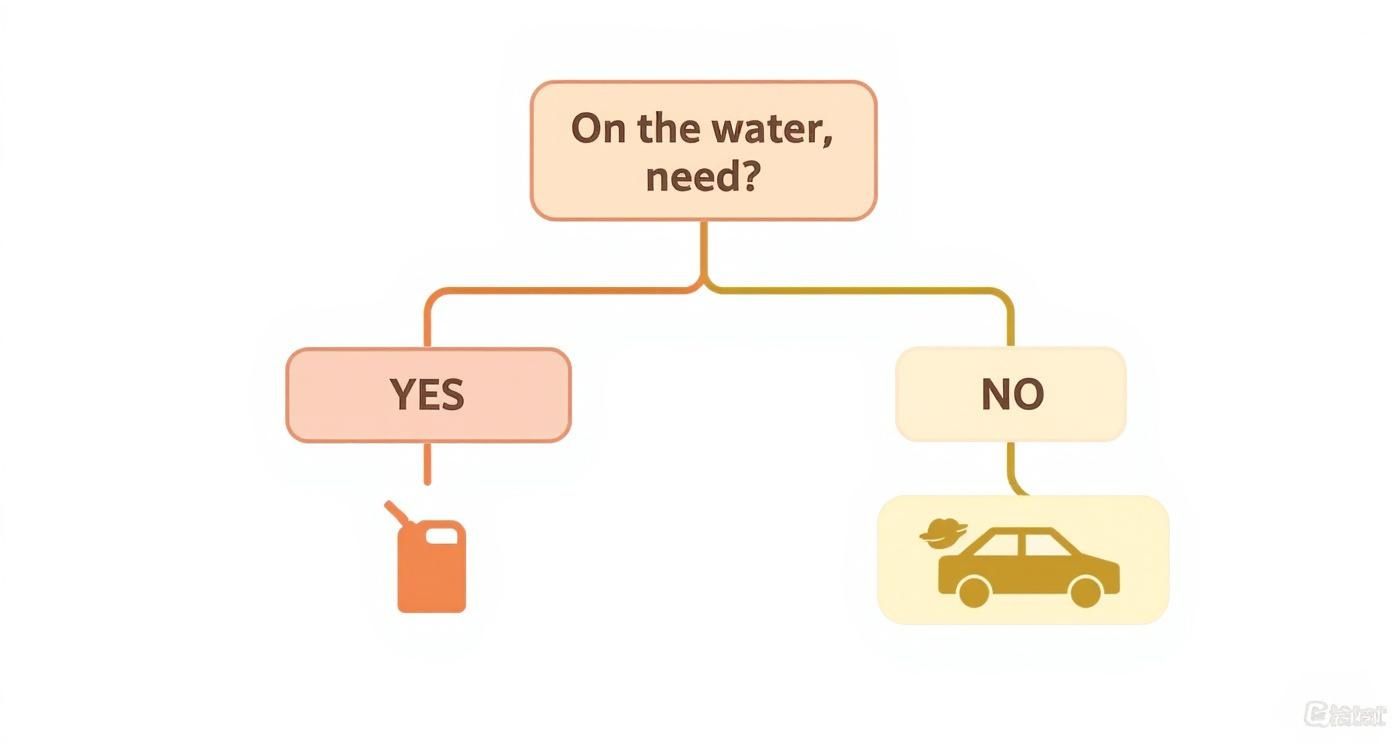
As the graphic shows, having extra fuel on hand is just smart planning, no matter where your adventures take you.
Considering Traditional Metal Cans
While plastic may be more common these days, steel fuel cans haven't disappeared—and for good reason. Their main selling point is rugged durability and puncture resistance. If you're running a commercial fishing boat or storing your cans where they might get knocked around by heavy equipment, a metal can offers a level of protection plastic just can't match.
Metal cans also tend to swell and contract less with big temperature swings. The big downside, though, is rust. Even steel cans that are coated or galvanized can start to corrode the moment they get a deep scratch, which is almost inevitable on a working boat. They're also a lot heavier, making them more of a chore to handle.
Comparing Plastic vs Metal Cans for Marine Use
To make the choice clearer, let's put them side-by-side. This table breaks down the key differences when you’re thinking about using these cans on a boat.
| Feature | Plastic (HDPE) Cans | Metal (Steel) Cans |
|---|---|---|
| Corrosion Resistance | Excellent. Immune to rust from salt and moisture. | Poor. Prone to rusting if scratched or damaged. |
| Weight | Lightweight and easy to carry, even when full. | Heavy and cumbersome, especially larger sizes. |
| Durability | High impact resistance but can be punctured. | Extremely rugged and puncture-resistant. |
| UV Resistance | Good, but can degrade with prolonged sun exposure. | Excellent. Unaffected by sunlight. |
| Cost | Generally more affordable. | Typically more expensive upfront. |
| Heat Swelling | Can swell or contract with temperature changes. | More dimensionally stable in heat. |
Ultimately, what this shows is a trade-off. Plastic wins on weight and corrosion resistance, while metal is the undisputed champ for sheer toughness.
Key Design Features for Boaters
Beyond just the material, a few specific features can make a world of difference when you're refueling on a rocking boat.
- Self-Venting Spouts: A good spout lets air flow in as fuel flows out. This stops that annoying "glug-glug" that almost always leads to splashing fuel everywhere.
- Ergonomic Handles: Trying to pour fuel with one hand while balancing on a boat is a recipe for disaster. Look for cans with multiple, comfortable handles that allow for a firm, two-handed grip for better control.
- Secure Sealing Caps: A cap with a quality gasket is a must. It keeps fuel from leaking out and, just as importantly, keeps flammable vapors from escaping into the air.
The best portable fuel can for your boat is one that blends seamlessly into your routine. It should be easy to handle, pour cleanly, and withstand the specific conditions you boat in, whether that's calm lake water or corrosive saltwater.
For the vast majority of recreational boaters, a high-quality, marine-rated HDPE plastic can is going to be the smartest choice. It offers the best mix of safety, user-friendly features, and durability needed for a stress-free day on the water.
Matching Your Fuel Can to Your Fuel Type
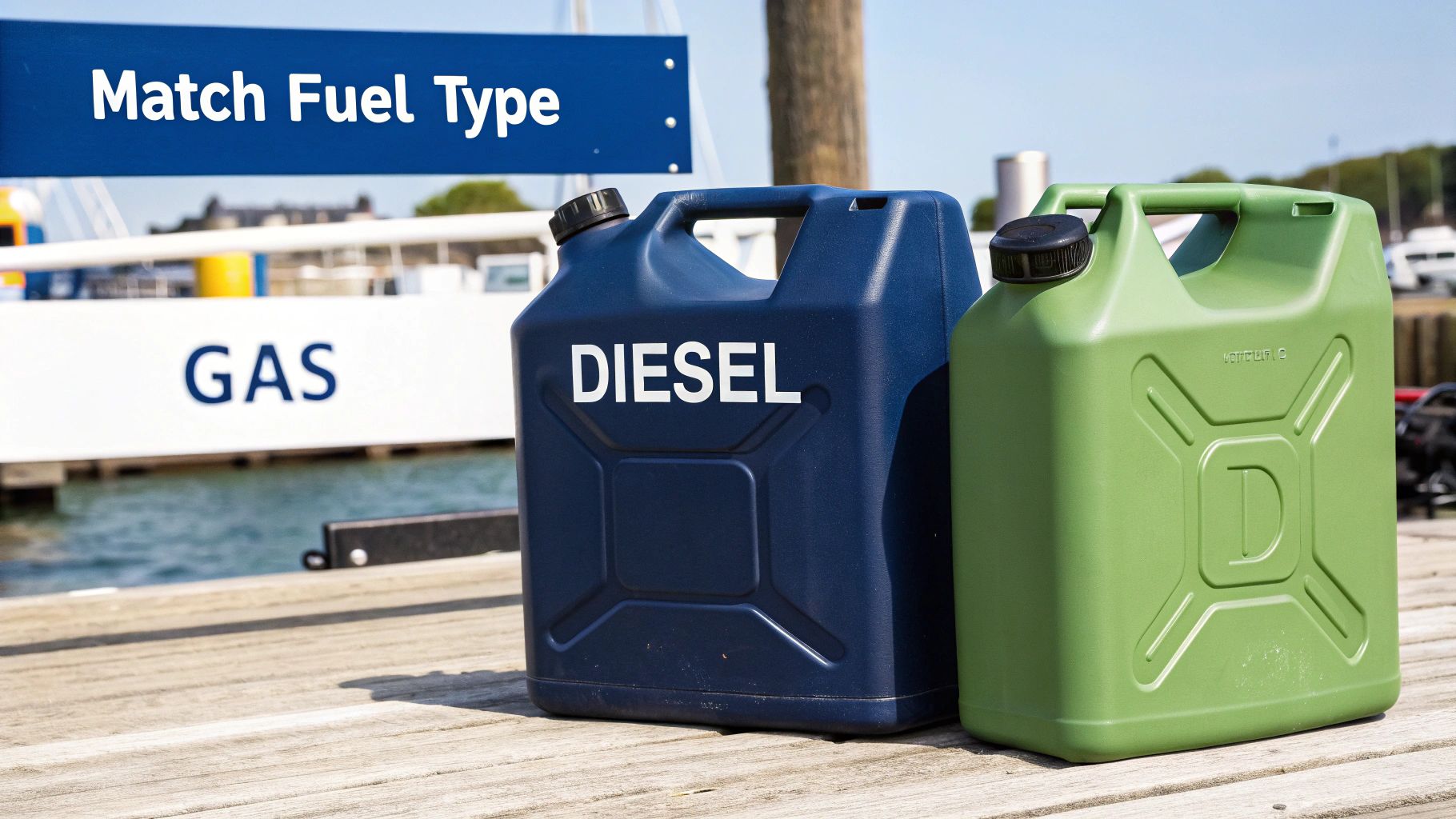
Putting the wrong fuel in your boat’s engine is a nightmare scenario. It’s an expensive, engine-killing mistake that can end your day on the water—and maybe your whole season. Think of it like a blood transfusion; you can't afford to get the type wrong.
Your portable fuel can is the first and most important line of defense against that kind of mix-up. This is where a simple, universally recognized system comes into play. The color of your fuel can isn't just for show; it's a critical safety signal telling you what's inside with just a glance. Getting this right is non-negotiable for any boater.
The Essential Fuel Can Color Code
The color-coding system for fuel cans was designed to be dead simple, preventing you from accidentally grabbing the wrong one. While you might see other colors out there for things like kerosene (often blue), the two you absolutely must know for boating are red and yellow.
Here's the breakdown:
- Red Cans are for Gasoline: Red is the universal color for gasoline. If you see a red portable fuel can, it should only ever have gasoline or a gas-oil mix for a two-stroke engine inside. Simple as that.
- Yellow Cans are for Diesel: Yellow cans are strictly for diesel fuel. The bright, distinct color makes it nearly impossible to mistake it for a gas can, preventing a catastrophic mix-up.
Sticking to this code is the easiest way to protect your engine. All it takes is one moment of distraction at the dock to grab the wrong can and cause thousands of dollars in damage.
Why the Right Material Matters Just as Much
Beyond the color, the actual material of the can is engineered for a specific type of fuel. Grabbing an old water jug or an unrated container is more than just a bad idea—it’s seriously dangerous. The potent chemicals in gasoline and diesel will eat away at improper plastics.
As the plastic breaks down, it leaches nasty chemical residues straight into your fuel. Once that contaminated fuel gets into your engine, it can clog fuel lines, foul injectors, and lead to poor performance or even complete engine failure.
Always use a fuel can that is explicitly rated for the type of fuel you're storing. Think of the container as part of a system designed to hold a specific chemical. Compromising that system is just asking for trouble.
Practical Tips for Keeping Your Fuel Clean
Clean, pure fuel is the lifeblood of a healthy engine. Contamination from water, dirt, or other gunk is a surprisingly common problem, and it often starts when you're transferring fuel from your portable can to the boat. The good news is, preventing it just takes a few good habits.
A clean transfer starts with the right gear and a little bit of care. Before you even twist the cap, you can take simple steps to ensure only pristine fuel makes it into your tank.
Your Checklist for a Clean Fuel Transfer
- Wipe Everything Down: Before you open the can, give the top and the area around your boat’s fuel intake a quick wipe. This simple step stops dust, dirt, or water from falling into your clean fuel.
- Check the Seal: Take a look at the rubber gasket inside the fuel can's cap. If it's cracked or worn out, it can let moisture in and allow dangerous fumes to escape.
- Use a Filter Funnel: This is one of the best, cheapest investments any boater can make. A funnel with a fine-mesh screen acts as a final line of defense, catching any debris that might have gotten into your can before it reaches your tank.
- Pour Slowly and Steadily: Don't rush it. Pouring too fast can cause splashing and overwhelm the filter in your funnel, letting junk slip through. A steady, controlled pour is cleaner and safer.
By making these simple steps part of your routine, you can be confident that the fuel going into your boat is just as clean as it was at the pump. It's easy diligence that protects your engine and prevents a lot of frustration on the water.
Of all the things to worry about on the water, you'd think a simple gas can wouldn't be one of them. But the rules for carrying a portable fuel can on your boat aren't just red tape—they're all about preventing a good day from turning into a disaster.
The U.S. Coast Guard and the Environmental Protection Agency (EPA) have a web of rules that all circle back to a single goal: keeping fuel and its fumes contained. When you understand why these rules exist, following them feels less like a chore and more like common sense.
What Makes a Fuel Can "Approved"?
At the core of it all is the requirement for an "approved" container. This isn't just a friendly suggestion; it's the law. An approved can is one that’s been put through the wringer by safety organizations like Underwriters Laboratories (UL) or ASTM International and lived to tell the tale.
When you see that UL or ASTM stamp, it’s a seal of approval that says the can has passed some tough tests for:
- Durability: It won't split open if it gets knocked around or dropped.
- Pressure Resistance: It's built to handle the pressure that fuel vapors create on a hot day without swelling up like a balloon.
- Spout Functionality: The nozzle is designed to pour without gushing and to keep spills to a minimum.
Tempted to use an old milk jug or a water bottle in a pinch? Don't. Those plastics aren't made to handle gasoline, which can eat right through them or let flammable vapors escape, essentially turning your boat into a floating fire hazard.
Vents and Vapors: Storing Your Can Onboard
Gasoline is tricky stuff. It constantly wants to turn into an invisible, highly explosive gas. That's why managing fuel vapor is a huge part of marine safety. Regulations require your portable can to have a way to vent safely, letting off just enough pressure to prevent the container from rupturing.
Modern cans have smart features like automatic vents or spill-proof spouts to handle this. But where you put the can matters just as much. The Coast Guard is clear on this: store portable fuel cans in a well-ventilated spot. Keep them far away from the engine, heat sources, and especially any enclosed living spaces where fumes could collect.
Storing a fuel can is about managing invisible risks. It’s not just about securing a physical object; it's about controlling flammable vapors to prevent them from gathering in a confined area.
The Spark of Truth: Why Grounding Matters
Here’s one of the most important—and most overlooked—safety steps: grounding the can while you refuel. As fuel sloshes around inside a can or pours through a nozzle, it can build up a static electric charge. It’s the same science behind the small shock you get after walking across a carpet and touching a doorknob.
That tiny, harmless spark can be catastrophic around gasoline fumes. To stop it from ever happening, safety rules demand that you keep the nozzle of the fuel can in constant metal-to-metal contact with your boat's fuel fill pipe. This connection gives any static charge a safe path to dissipate—or "ground"—before it can build up and jump as a spark.
It also goes without saying that you should never fuel near a hot engine or any open flame. Staying current with these practices is non-negotiable, and understanding the science behind them is a big part of proper environmental compliance training.
This focus on safety isn't just a local concern. Globally, the portable fuel tank market was valued at around USD 1.2 billion in 2023 and is projected to keep growing, driven by boating, farming, and other industries. You can dive deeper into these trends in this detailed portable fuel tank market report. This growth just highlights how critical it is to have containers that meet tough safety and environmental standards.
When you follow these rules, you’re not just avoiding a fine. You’re protecting yourself, your passengers, and everyone else sharing the water with you.
Safe Handling and Storage Practices for Boaters
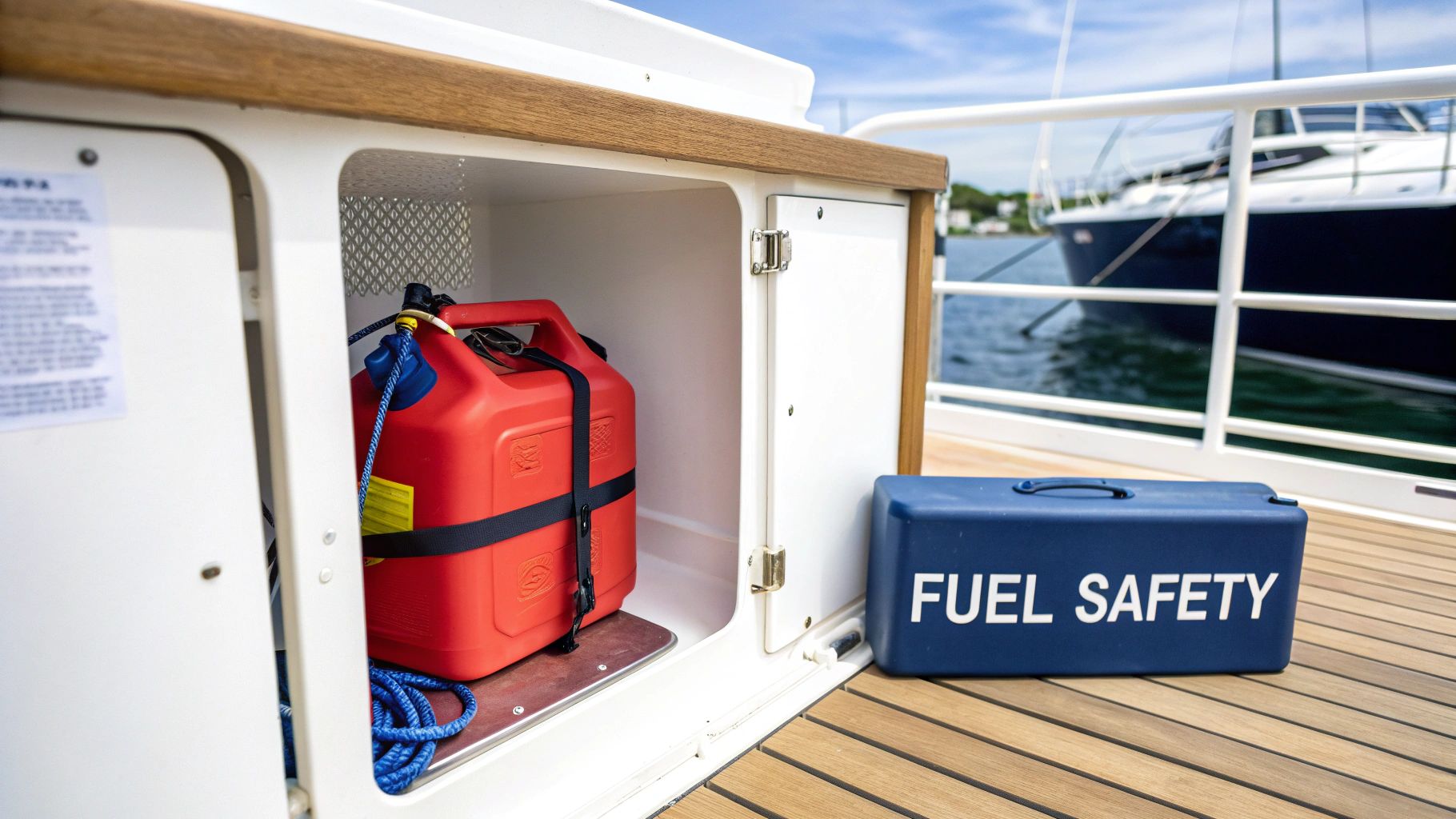
Knowing the rules for your portable fuel can is important, but making safety a habit is what really keeps you out of trouble on the water. Think of it like a pilot's pre-flight checklist. It's not optional; it's a simple routine you follow every single time to guarantee a safe trip.
When you create a reliable system for storing and using your fuel cans, you eliminate the guesswork and dramatically cut down on risk. It all comes down to knowing exactly where to keep them onboard, how to tie them down for rough seas, and the right way to get fuel into your tank without a single drop hitting the water.
Onboard Fuel Can Storage Best Practices
A loose fuel can sliding around on deck is more than an inconvenience—it’s a projectile waiting to happen. In choppy water, an unsecured can could smash into equipment, get damaged, or even rupture. That’s a serious hazard.
Proper onboard storage really boils down to two things: ventilation and security.
Your number one priority is to store cans somewhere with plenty of airflow, far away from any potential spark. That means keeping them clear of the engine compartment, batteries, or any enclosed cabin spaces where fumes could build up. An open deck or a dedicated, vented locker is your best bet.
A fuel can’s biggest threat isn’t a flame, but the invisible vapors it releases. Good ventilation lets those vapors blow away safely instead of collecting in a tight space where one spark could spell disaster.
Also, try to keep your cans out of direct sunlight. The sun’s heat causes the pressure inside to build up, making the can swell and stressing its seals. A shaded, secure spot is always the way to go.
Securely Refueling Your Boat Step by Step
Pouring fuel from a portable can into your boat's tank is when spills are most likely to happen. By turning it into a methodical, step-by-step process, you can make this critical task a safe and routine part of boating.
- Prep Your Space: Before you even twist a cap, make sure your boat is tied up securely. Get your fire extinguisher and some absorbent pads out and have them within arm's reach. And on that note, knowing how to operate a fire extinguisher is a non-negotiable skill for every boater.
- Ground the Can: Touch the metal nozzle of the fuel can directly to the metal rim of your boat's fuel fill pipe, and keep them touching the entire time you pour. This simple move prevents static electricity from building up and creating a dangerous spark.
- Pour Slowly and Steadily: Use two hands for a solid grip and pour at a controlled rate. Rushing is what causes that "glugging" sound, which inevitably leads to splashes and spills. A good funnel can make this much easier and safer.
- Don't Overfill: Pay attention to the sound as the tank gets close to full. Resist the urge to top it off to the absolute brim. Fuel expands when it gets warm, and you need to leave a little room for it to do so without overflowing from the vent.
- Clean Up: When you're done, screw the caps back on tightly—both on the can and your boat's tank. Immediately wipe up any drips with an absorbent cloth and dispose of it properly.
Shoreside Storage Rules to Follow
How you store your portable fuel cans on land is just as critical. The perfect spot is a detached shed or garage that’s cool, dry, and well-ventilated. Never, ever store gasoline inside your house or even in an attached garage where fumes could find their way into your living space.
- Keep It Off the Floor: Store cans on a shelf or another raised surface to protect them from moisture and accidental kicks.
- Away from Ignition Sources: Make sure there are no flame-producing appliances nearby, like a water heater or furnace.
- Give Them a Quick Check: Every now and then, look over your stored cans for any signs of leaks, cracks, or wear and tear.
For a deeper dive, check out our guide on https://clixfueling.com/blogs/news/how-to-store-gasoline-safely for more essential tips. By making these practices second nature, you ensure your portable fuel can is a helpful tool, not a ticking time bomb.
Solving Common Problems with Portable Fuel Cans
https://www.youtube.com/embed/gpQqQkBkBbU
Even the best portable fuel can is going to give you a little grief now and then. We’ve all been there—dealing with swollen cans on a hot day or a spout that glugs and splashes fuel everywhere. These are common headaches, but the good news is they usually have a simple fix. Once you understand what's going on, you can solve these problems in a snap.
The Swollen Can Mystery
One of the most frequent things you'll see, especially in the summer heat, is a plastic fuel can puffed up like a balloon. Don't worry, it's not about to explode. This is actually a sign the can is doing its job. As the temperature rises, the fuel inside creates vapor, and that pressure causes the flexible HDPE plastic to expand.
To fix it, just move the can into the shade or a cooler spot. Then, making sure you're far away from any sparks or flames, slowly twist the cap open. You'll hear that classic hiss as the pressure escapes. The can will shrink right back to its normal shape.
Taming the Slow, Glugging Pour
Ah, the dreaded "glug-glug-splash." You're trying to pour, but the fuel comes out in sputtering bursts, splashing onto the dock or your deck instead of into the tank. This happens because air can't get into the can fast enough to replace the fuel flowing out, creating a mini-vacuum.
Here’s how to get a smooth, clean pour every time:
- Use Two Hands: It sounds basic, but a solid, two-handed grip gives you way more control.
- Angle the Can: Try tilting the can so the spout is positioned at the top edge. This little trick creates an air channel, allowing air to flow in as the fuel flows out.
- Vent if Possible: If you have an older can with a dedicated vent cap on the back, pop it open before you pour. It makes all the difference for a fast, smooth flow.
Fixing Leaky Gaskets
Another simple but messy problem is a leaky gasket. The rubber ring inside the cap can wear out over time, and once it's cracked or brittle, it won't create an airtight seal. This lets dangerous vapors escape and can cause fuel to dribble out. Check your gaskets every so often and replace them if they look worn.
Of course, spills can still happen. For a complete rundown on how to handle these situations, this guide to hazardous waste and spill cleanup is a fantastic resource.
A stubborn fuel can is often just a simple physics problem in disguise. Understanding pressure and airflow can turn a frustrating task into a routine one.
These cans are a staple for a reason. In fact, portable fuel containers are a huge part of the fuel storage market, holding a 36% market share in 2025. You can discover more insights about the fuel container market on Fact.MR. Learning these quick troubleshooting tips will keep your can working reliably. And if you do have a spill, make sure you're prepared by reading our expert guide on fuel spill cleanup procedures.
Your Fuel Can Questions, Answered
Even when you know the rules, real-world situations pop up. Let's tackle some of the most common questions boaters ask about handling their portable fuel cans so you can feel confident you're doing it right.
How Long Is Gas Good for in a Fuel Can?
This is a big one. Generally, untreated gasoline in a sealed, approved can is good for about three to six months. After that, it starts breaking down, creating gummy deposits that can wreak havoc on your boat's engine.
The easy fix? Pour a quality fuel stabilizer into the can right after you fill it up. It’s a simple, inexpensive step that can keep your fuel fresh and ready to go for a year or even longer. Think of it as cheap insurance for your engine.
Is It Okay to Carry a Full Gas Can in My Car?
Honestly, you should avoid this whenever possible. The bed of a truck is always the safest place. In an enclosed space like a car's trunk or cabin, flammable fumes can accumulate fast, creating a serious fire hazard.
If you absolutely have no other choice for a short trip, take these precautions:
- Triple-check the cap. Make sure it's screwed on as tight as it can go to lock in the vapors.
- Keep it upright. Wedge the can securely in your trunk so it can’t tip over on a turn or a sudden stop.
- Ventilate. Crack a window to keep fresh air circulating.
- Get it out ASAP. As soon as you arrive, take the can out of your car.
Help! My Plastic Fuel Can Looks Swollen. What Do I Do?
Seeing your fuel can puffed up like a balloon on a hot day can be unsettling, but don't panic! This is actually normal. As the temperature rises, the fuel creates vapor, and that pressure causes the can to expand. The plastic is designed to flex and handle this.
A swollen fuel can isn’t a sign of failure; it’s a sign the can is doing its job. The trick is to release that built-up pressure safely.
First, move the can to a shady, cool spot. Then, making sure you're outdoors and far from any potential sparks (no smoking!), slowly and carefully twist the cap open. You’ll hear a "hiss" as the pressure escapes. Once the can is back to its normal shape, you can tighten the cap back down.
The best way to handle fuel safely is to prevent spills before they happen. The system from CLiX Fueling Solutions takes the guesswork out of filling up by automatically shutting off the nozzle when your tank is full. No more spills, no more overfills. Check out a cleaner, smarter way to fuel your boat at https://clixfueling.com.

